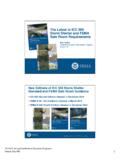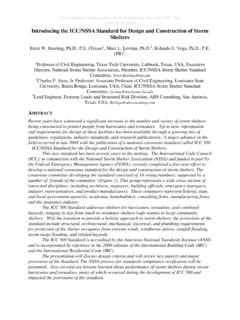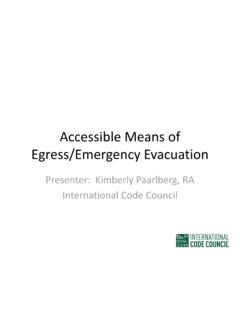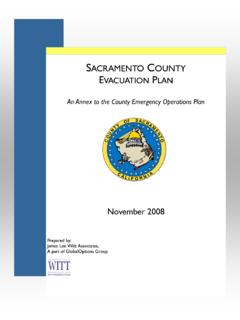Transcription of Storm Shelters: Selecting Design Criteria
1 Page of 5 Storm shelters : Selecting Design Criteria HSFEHQ-07-J-0020 / August 2007 Purpose and Intended AudienceThe intended audience for this Tornado Recovery Advisory (RA) is anyone involved in the planning, policy-making, Design , construction, or approval of tornado shelters , including designers, emergency managers, public officials, policy or decision makers, building code officials, and home or building owners. Homeowners and renters should also refer to the Tornado RA titled Residential Sheltering: In-Residence and Stand-Alone shelters . The purpose of this advisory is to present information on different types of shelter Design guidelines, code requirements, and other Criteria that pertain to the Design and construction of tornado shelters .
2 There are various Storm shelter Criteria , each of which offers different levels of protection to its shelter Recovery Advisory Addresses:How shelter construction is different from typical building construction:Structural systemsWindborne debris resistanceDesign Criteria for different types of sheltersUseful links and shelter resourcesHow Shelter Construction is Different from Typical Building ConstructionA tornado shelter is typically an interior room, space within a building, or an entirely separate building, designed and constructed to protect its occupants from tornado wind forces and windborne debris. The level of occupant protection provided by a space specifically designed as a shelter is intended to be much greater than the protection provided by buildings that comply with the minimum requirements of building codes.
3 The model building codes do not provide Design and construction Criteria for life safety for sheltering, nor do they provide Design Criteria for withstanding the forces of typically fall into two categories: residential shelters and community (non-residential) tornado shelters are constructed as in-residence or easily accessible external shelters . An in-residence shelter, also called a safe room, is a small, specially designed ( hardened ) room, such as a bathroom or closet that is intended to provide a place of refuge for the people who live in the house. An external residential shelter is similar in function and Design , but it is a separate structure installed outside of the house, either above or below ground.
4 Refer also to the Tornado RA titled Residential Sheltering: In-Residence and Stand-Alone community shelter is intended to protect a large number of people, anywhere from 12 to as many as several hundred individuals. These shelters include not only public shelters , but also private shelters for businesses and other organizations. See these 2007 Tornado Recovery Advisories for information about sheltering from tornadoes:Tornado Risks and Hazards in the Midwest United States (Tornado RA1)Residential Sheltering: In-Residence and Stand-Alone shelters (Tornado RA 3) Storm shelters : Selecting Design CriteriaThe term hardened refers to specialized Design and construction applied to a room or building to allow it to resist wind pressures and windborne debris impacts during a high-wind event and serve as a 2007 TORNADO RECOVERY ADVISORY FEMA DR-1699-RA2 Storm shelters .
5 Selecting Design Criteria HSFEHQ-07-J-0020 / August 2007 Page 2 of 5 Structural SystemsThe primary difference in a building s structural system when designed for use as a shelter, versus conventional use, is the magnitude of the wind forces it is designed to are designed to withstand a certain wind speed (termed Design [basic] wind speed ) based on historic wind speeds documented for different areas of the country. The Design wind speed used in conventional construction in the Midwest is a 90 mph, 3-second gust. By contrast, the Design wind speed recommended by FEMA1 for shelters in this same area is a 250 mph, 3-second gust to provide near-absolute protection.
6 2 Wind pressures are calculated as a function of the square of the Design wind speed. As a result, the structural systems of a shelter are designed for forces several times higher than those used for typical building construction. Consequently, the structural systems used in shelters (and the connections between them) are very Debris Resistance Windborne debris, commonly referred to as missiles, causes many of the injuries and much of the damage from tornadoes. Windows and the glazing in exterior doors of conventional buildings are not required to resist windborne debris, except for those in windborne debris regions (which are limited to hurricane-prone regions).
7 3 Debris protection includes impact-resistant glazing, which can either be laminated glass or polycarbonate, and coverings such as shutters. The ASCE 7 missile Criteria were developed to minimize property damage and improve building performance; they were not developed to protect occupants. To provide occupant protection, the Criteria used in designing shelters include substantially greater windborne debris roof deck, walls, and doors of conventional construction are also not required by the building code to resist windborne debris. However, the roof deck and walls around a shelter space, and the doors leading into it, must resist windborne debris.
8 Additional information regarding the different levels of windborne debris loads is provided below. Design Criteria for Different Types of shelters shelters provide different levels of protection depending on the Design Criteria used. The level of protection provided by a shelter is a function of the Design wind speed (and resulting wind pressure) used in designing the shelter, and of the windborne debris load wind speed and wind pressure Criteria : The required Design strength of the shelter is dictated by wind pressure Criteria given by different guides, codes, and standards. The Design wind pressure is a function of the Design wind speed. In FEMA s shelter publications (see Useful Links on page 3), recommended Design wind speeds range from 160 to 250 mph.
9 However, the 2006 International Residential Code and the 2006 International Building Code, which establish the minimum requirements for residential and other building construction, include a Design wind speed of 90 mph in the Midwest. The table on page 4 compares shelter Design Criteria options. The table on page 5 presents comparative data for two locations using the Design Criteria presented on page FEMA 361, Design and Construction Guidance for Community shelters (July 2000), available online at Near-absolute protection means that, based on our knowledge of tornadoes and hurricanes, a shelter built according to this guidance will protect its occupants from injury or death.
10 FEMA 361, page 1-2, Design and Construction Guidance for Community shelters (2000).3. ASCE 7, American Society of Civil Engineers Standard 7, Minimum Design Loads for Buildings and Other Structures (2005).If glazing is present in a tornado shelter, it should be protected by an interior-mounted shutter that can be rapidly deployed by the shelter Storm shelter being constructed to FEMA 361 Criteria in Wichita, of 5 Storm shelters : Selecting Design Criteria HSFEHQ-07-J-0020 / August 2007 Windborne debris load Criteria : The table below presents windborne debris Criteria given in current FEMA guidance and a proposed International Code Council standard.




